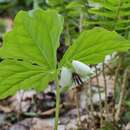fr
noms dans le fil d’Ariane


Trillium rugelii has been much confused with T. cernuum in past floras, and it is the taxon upon which most reports of T. cernuum south of Virginia are based.
Trillium rugelii, also known as the southern nodding trillium[2] or illscented wakerobin,[3] is a species of flowering plant in the family Melanthiaceae. It is native to parts of the southeastern United States. It is found in the Great Smoky Mountains,[4] Fernbank Forest, Steven's Creek Heritage Preserve, and other places of the Piedmont and southern Appalachian Mountains in Alabama, Georgia, South Carolina, North Carolina and Tennessee.[5] It prefers to grow near streams in humus-rich soil under the shade of deciduous trees.
Trillium rugelii is a perennial herbaceous plant that blooms mid April to May.[6] Like some other trillium species (such as T. catesbaei, T. cernuum, and T. vaseyi), its flower hangs below the leaves. In the past, many authors incorrectly cited specimens as Trillium cernuum, which has a similar though smaller flower with shorter stamens and thinner petals. Also, T. cernuum grows farther north and is less robust.
As of 2009 the species is endangered in Tennessee,[7] Georgia, and other parts of the United States.[8]
Trillium rugelii, also known as the southern nodding trillium or illscented wakerobin, is a species of flowering plant in the family Melanthiaceae. It is native to parts of the southeastern United States. It is found in the Great Smoky Mountains, Fernbank Forest, Steven's Creek Heritage Preserve, and other places of the Piedmont and southern Appalachian Mountains in Alabama, Georgia, South Carolina, North Carolina and Tennessee. It prefers to grow near streams in humus-rich soil under the shade of deciduous trees.
Trillium rugelii is a perennial herbaceous plant that blooms mid April to May. Like some other trillium species (such as T. catesbaei, T. cernuum, and T. vaseyi), its flower hangs below the leaves. In the past, many authors incorrectly cited specimens as Trillium cernuum, which has a similar though smaller flower with shorter stamens and thinner petals. Also, T. cernuum grows farther north and is less robust.